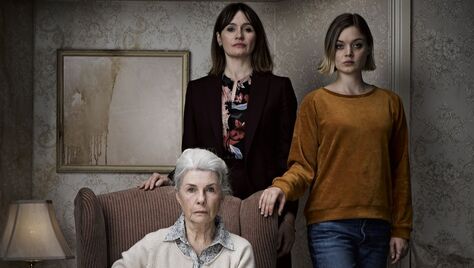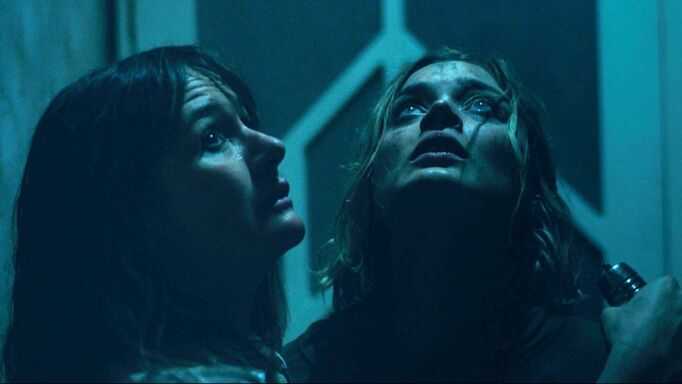 In Relic, directed by Natalie Erika James and written by James and Christian White, when ailing family matriarch Edna (Robyn Nevin) goes missing, her daughter Kay (Emily Mortimer) and granddaughter Sam (Bella Heathcote) rush to her home to search for her... ...Convinced dementia has invaded her mind and frightened her into running from home, they consider placing Edna in an elder care facility, despite their distress at the idea. As Edna’s increasing hallucinations snatch pieces of family history, her home, and her descendants’ minds, the house begins to reflect the decaying state of Edna’s thoughts. First off, I want to give the caveat that this movie undertakes two things I cannot abide: 1. It conflates mental illness with demonic possession. 2. It abandons its convention. The conflation of the concepts of mental illness and demons has never sat particularly well with me. The two horrors are not mutually exclusive, necessarily, but to be a responsible horror film, the differences have to be made clear, at least for this viewer. Unfortunately, I believe this movie does not distinguish between them at all. As mentioned in the synopsis, Kay and Sam go to take care of Kay’s mother whose dementia seems to be growing, which is plenty scary. To see how well this can be done, see True Detective’s third season starring power couple Mahershala Ali and Carmen Ejogo. That time and space warp that happens when the brain and its memory start to disintegrate is so heart wrenching and disorienting that, truly, that one convention would be plenty. In that scenario, Edna is the victim of her own mind. Her mind does not seem to be the consistent antagonist, though. In fact, the other characters grow to fear Edna herself. She attacks Sam, is mean to her mentally disabled neighbor, and seems to trap people in her house. Plus, there’s the unconfirmed family history, explored via shared nightmare, that someone was previously tortured in the cabin outside the house. The audience then grows to believe that Edna is the antagonist. That is, until she sees someone else in her home, a man made of shadows that emerges from her attic. I had high hopes for this film. The cast is impeccable: Emily Mortimer is such a watchable performer. She can do so much with her face. Bella Heathcote never had me questioning her authenticity a single time. The film even manages to make the back of Robyn Nevin’s head terrifying with some impressive framing, her white hair billowing down and around her shoulders and curtaining either side of her confused, placid expression. I never had to suspend my disbelief when she acted like the woman with dementia that she was; scared, girlish, forgetting her own commitments and gifts, to her family’s terror and dismay. The set of her house is so believable—I remember thinking, “There’s going to be a clue in that sweater on the chair” and “Oooh, what is that candle-making tool?” among other hot-take observations. Now, I love a good investment in the Gothic trope of the madwoman in her house/attic as much as any viewer. The trope began with the Victorian period’s “Yellow Wallpaper” in response to women’s lack of options outside the domestic sphere and presented a case for the maddening effects of such stifling conditions, and persists in modern interpretations, like Darren Aronofsky’s Mother!. Relic, however, seems to break from that idea just when you think that’s what it’s going for. Edna is not trapped, but rather goes missing from the house until she just shows back up, disoriented and somewhat upset, asking her daughter deadpan, “Tea?” Relic could be so scary if I didn’t have to think so much. That may sound like a cop-out, but my brain was so busy trying to put the pieces of the plot together that I couldn’t enjoy the things that were working, like the direction, the performance, even the special effects. All that would be okay if at some point the fragments could congeal into a narrative arc, but that never happened for me. The film copy says the house indicates dementia, and I suppose that is true, but I was left with so many more questions about the film’s convention: what’s real and what isn’t? If I can’t tell the difference even though I’m trying, what was the purpose in making the reality ambiguous? If the house is Edna’s dementia manifested, how do other characters get caught in it? What’s the point of the nightmare cottage? —I really wanted that to come back in. As it stands, it seems like just a red herring. Perhaps that is the nature of dementia, but in order to effectively scare a viewer, there has to be some sort of touchstone that grounds us in the film’s convention, and Relic just doesn’t have that—I mean, what is the relic? All things considered, the main failure of this film for me is the actual script—the film itself is so watchable. Dead bodies move convincingly. The home is invaded by shadow creatures that only Edna sees. The attic turns into a labyrinth of memories and notes to self… I just wish I could understand the connection between these elements. Relic comes to VOD July 10th from IFC Midnight. By Mary Kay McBrayer Enjoy Mary Kay's writing? Check out her true crime book, America's First Female Serial Killer: Jane Toppan and the Making of a Monster, available now through Amazon.
0 Comments
Leave a Reply. |
Archives
March 2023
|


 RSS Feed
RSS Feed